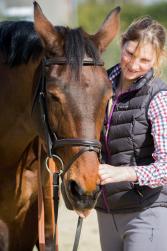Animal Skeletal Therapy
Animal manipulation was first introduced by John McTimoney DC in the early 1970s, the technique was refined by Hugh Corley DC (OSC) later in that decade. In the 1980s, animal treatment was further developed and expanded by Shelagh James-Hudson DC (WSC).
The McTimoney-Corley technique has been adapted to treat most animals. Horses, for example, are large and normal methods applied to humans would have little effect on a horse. It is therefore important to realise that, just because a therapist has trained to treat humans, it doesn’t automatically follow that they are able to treat animals as well. Whilst human physiology also applies to animals in many ways, animals with their four legs have different types of body structure, digestive systems, behaviours, different diseases/ailments, and require different skills from the therapist.
Why do animals suffer from back problems?
Horses
It is no surprise that horses can very often suffer musculoskeletal problems. Whilst they are strong and capable of carrying humans on their backs, their riders’ bodies are often out of balance which causes stress and pain to the horse’s back. We then ask them to jump for us, run races, work in collection and dance to music. Ill-fitting saddlery, injury through trauma, stress and over-exertion through performance, digestive upset, illness, joint problems, disease, bad shoeing and dentistry are also some other examples that can lead to back problems. The wearing of head collars can often cause neck injuries, especially if the head collar doesn’t break (nylon) in a panic situation.
Dogs
Whilst dogs don’t have riders to contend with, they can still suffer from musculoskeletal problems. Perhaps those more commonly affected are performance dogs e.g., dogs taking part in agility tests, racing or country sports. Performance dogs suffer from the same stresses, strains and trauma injuries that human athletes do. Wearing collars is a common factor in creating problems – intense pulling, getting the collar caught etc can cause misalignments of the neck vertebrae. If a dog is over-weight or unfit, he is also more likely to suffer from back problems, as his lack of muscle tone and skeletal frame will have the extra burden of weight to carry. Various breeds suffer congenital (inherited) problems, for instance hip dysplasia in labradors. Older dogs may suffer from arthritis leading to gait abnormalities, which can eventually lead to a bad back. Dogs can also lie on bedding which doesn’t provide them with enough support whilst sleeping – like humans their backs need good support to remain healthy.
Cats
Cats have very flexible spines, can jump and climb effectively, and also have an excellent, self-righting reflex that allows them to land properly in the event of a fall. (Cats really do appear to have nine lives!). Although the risk of them suffering from a bad back is likely to be less common than for horses and dogs, they can still be affected. Like dogs, some cats wear collars which, if caught up in fencing etc, can cause neck injuries. Getting involved in frequent fights can cause injury. The most common cause of structural/neurological problems is a vehicle accident. Also obesity, stress, illness and old age may also lead to back and joint problems.
- All AMCST Animal Practitioner members have a Code of Ethics to adhere to.
All our animal practitioners respect and conform to The Veterinary Surgeons Act 1966 and The Veterinary Surgery (Exemptions) Order 1962, to work within the confines of the law and to ensure clients are aware of these requirements
- Practitioners should explain to the client that it is their duty to gain prior veterinary approval before any treatment commences
- Practitioners must never make a diagnosis unless qualified to do so, nor contradict any diagnostic opinion given by a veterinary surgeon

